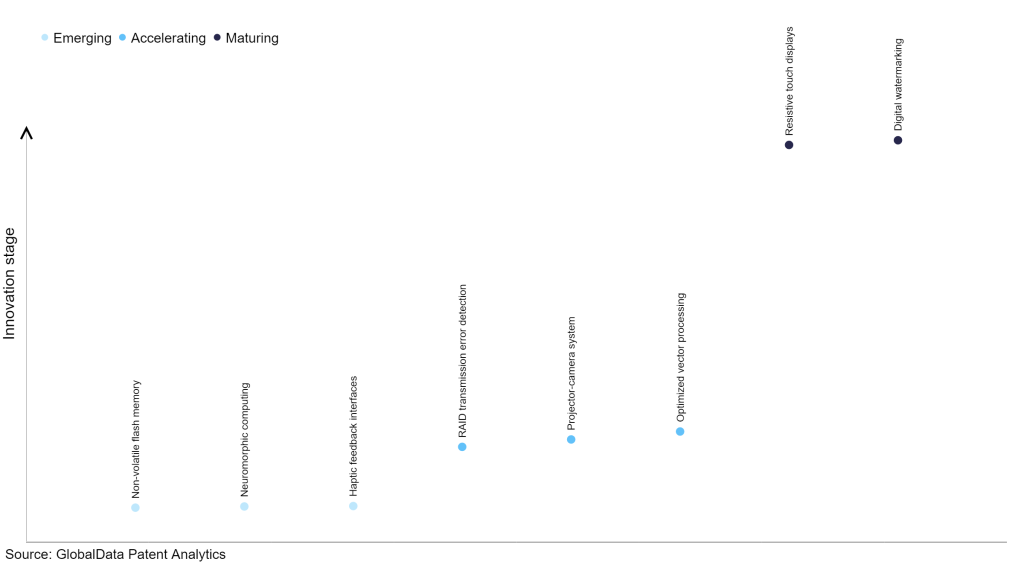The technology industry continues to be a hotbed of patent innovation. Activity is driven by need for agility, cost efficiency, and scalability in network operations. Also, growing importance of technologies such as network virtualization, software-defined networking (SDN), and cloud computing are driving the market. In the last three years alone, there have been over 1.5 million patents filed and granted in the technology industry, according to GlobalData’s report on Innovation in technology: virtual network functions. Buy the report here.
However, not all innovations are equal and nor do they follow a constant upward trend. Instead, their evolution takes the form of an S-shaped curve that reflects their typical lifecycle from early emergence to accelerating adoption, before finally stabilizing and reaching maturity.
Identifying where a particular innovation is on this journey, especially those that are in the emerging and accelerating stages, is essential for understanding their current level of adoption and the likely future trajectory and impact they will have.
185+ innovations will shape the technology industry
According to GlobalData’s Technology Foresights, which plots the S-curve for the technology industry using innovation intensity models built on over 1.6 million patents, there are 185+ innovation areas that will shape the future of the industry.
Within the emerging innovation stage, non-volatile flash memory, neuromorphic computing, and haptic feedback interfaces are disruptive technologies that are in the early stages of application and should be tracked closely. RAID transmission error detection, projector-camera system, and optimized vector processing are some of the accelerating innovation areas, where adoption has been steadily increasing. Among maturing innovation areas are resistive touch displays and digital watermarking, which are now well established in the industry.
Innovation S-curve for the technology industry

Virtual network functions is a key innovation area in technology
Virtual network functions (VNFs) are software-based network functions that are deployed on virtualized servers or cloud infrastructures. They provide the same network services as physical network appliances, such as firewalls, routers, and load balancers, but with the added benefits of flexibility and scalability. VNFs can be deployed quickly and cost-effectively and are often used in software defined networks (SDN) and network functions virtualization (NFV) architectures.
GlobalData’s analysis also uncovers the companies at the forefront of each innovation area and assesses the potential reach and impact of their patenting activity across different applications and geographies. According to GlobalData, there are 160+ companies, spanning technology vendors, established technology companies, and up-and-coming start-ups engaged in the development and application of virtual network functions.
Key players in virtual network functions – a disruptive innovation in the technology industry
‘Application diversity’ measures the number of applications identified for each patent. It broadly splits companies into either ‘niche’ or ‘diversified’ innovators.
‘Geographic reach’ refers to the number of countries each patent is registered in. It reflects the breadth of geographic application intended, ranging from ‘global’ to ‘local’.
Patent volumes related to virtual network functions
Source: GlobalData Patent Analytics
VMware is the top patent filer in virtual network functions, followed by Huawei and Cisco Systems. Other prominent filers in the space include Juniper Networks and Oracle.
By geographic reach, SentinelOne leads the pack, followed by Palo Alto Networks and VirnetX. In terms of application diversity, VMware holds the top position, followed by Huawei and Cisco Systems.
Innovation in virtual network functions (VNFs) refers to advancements in virtualizing network functions traditionally performed by dedicated hardware. VNFs enable the deployment and management of network services in a flexible and scalable manner. Major technologies involved in VNF innovation include network virtualization, software-defined networking (SDN), and cloud computing, which enable the virtualization and orchestration of network functions in a virtualized infrastructure.
To further understand the key themes and technologies disrupting the technology industry, access GlobalData’s latest thematic research report on Technology.
Data Insights
From

The gold standard of business intelligence.
Blending expert knowledge with cutting-edge technology, GlobalData’s unrivalled proprietary data will enable you to decode what’s happening in your market. You can make better informed decisions and gain a future-proof advantage over your competitors.







